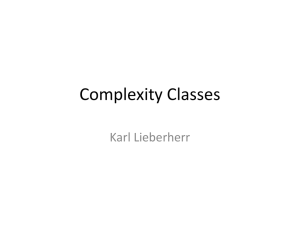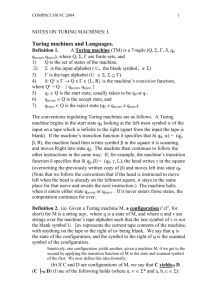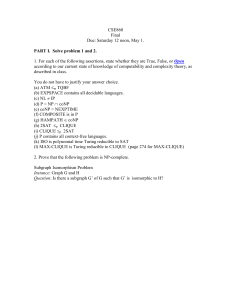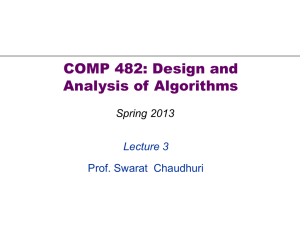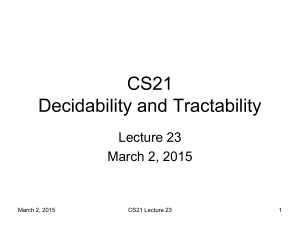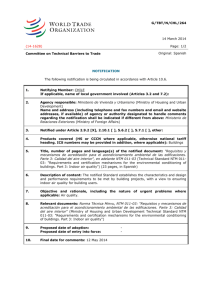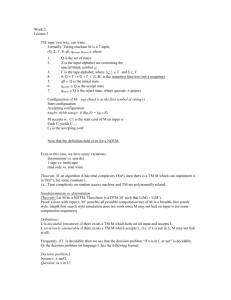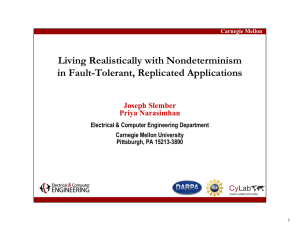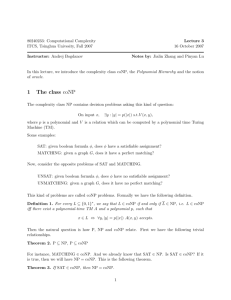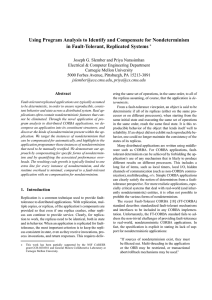lec3a
advertisement
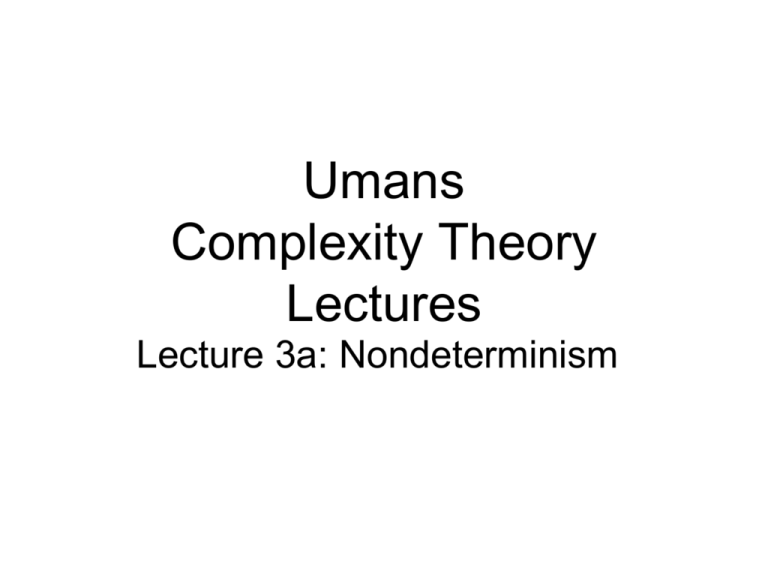
Umans
Complexity Theory
Lectures
Lecture 3a: Nondeterminism
Nondeterminism: introduction
A motivating question:
• Can computers replace mathematicians?
L = { (x, 1k) : statement x has a proof of
length at most k }
2
Nondeterminism: introduction
• Outline:
– nondeterminism
– nondeterministic time classes
– NP, NP-completeness, P vs. NP
– coNP
– NTIME Hierarchy
– Ladner’s Theorem
3
Nondeterminism
• Recall deterministic TM
– Q finite set of states
– ∑ alphabet including blank: “_”
– qstart, qaccept, qreject in Q
– transition function:
δ : Q x ∑ → Q x ∑ x {L, R, -}
4
Nondeterminism
• nondeterministic Turing Machine:
– Q finite set of states
– ∑ alphabet including blank: “_”
– qstart, qaccept, qreject in Q
– transition relation
∆ ⊊ (Q x ∑) x (Q x ∑ x {L, R, -})
• given current state and symbol scanned,
several choices of what to do next.
5
Nondeterminism
• deterministic TM: given current configuration,
unique next configuration
qstartx1x2x3…xn
x L
qstartx1x2x3…xn
xL
qaccept
qreject
• nondeterministic TM: given current configuration,
several possible next configurations
6
Nondeterminism
qstartx1x2x3…xn
xL
qstartx1x2x3…xn
xL
“computation
path”
“guess”
qaccept
qreject
• asymmetric accept/reject criterion
7
Nondeterminism
• all paths terminate
• time used: maximum length of paths from
root
• space used: maximum # of work tape
squares touched on any path from root
8
Nondeterminism
• NTIME(T(n)) = languages decidable by a
multi-tape NTM that runs for at most T(n)
steps on any computation path, where n is
the input length, and T :N → N
• NSPACE(S(n)) = languages decidable by
a multi-tape NTM that touches at most
S(n) squares of its work tapes along any
computation path, where n is the input
length, and S: N → N
9
Nondeterminism
• Focus on time classes first:
NP = k NTIME(nk)
NEXP = k
k
n
NTIME(2 )
10
Poly-time verifiers
“witness” or
Very useful alternate definition of NP:
“certificate”
efficiently
Theorem: language L is in NP if and
only if
verifiable
it is expressible as:
L = { x| ∃ y, |y| ≤ |x|k, (x, y) R }
where R is a language in P.
• poly-time TM MR deciding R is a “verifier”
11
Poly-time verifiers
• Example: 3SAT expressible as
3SAT = {φ : φ is a 3-CNF formula for which
assignment A for which (φ, A) R}
R = {(φ, A) : A is a sat. assign. for φ}
– satisfying assignment A is a “witness” of the
satisfiability of φ (it “certifies” satisfiability of
φ)
– R is decidable in poly-time
12
Poly-time verifiers
L = { x | ∃ y, |y| ≤ |x|k, (x, y) R }
Proof: () give poly-time NTM deciding L
phase 1: “guess” y
with |x|k
nondeterministic steps
phase 2:
decide if
(x, y) R
13
Poly-time verifiers
Proof: () given L NP, describe L as:
L = { x | ∃ y, |y| ≤ |x|k, (x, y) R }
– L is decided by NTM M running in time nk
– define the language
R = { (x, y) : y is an accepting computation
history of M on input x}
– check: accepting history has length ≤ |x|k
– check: R is decidable in polynomial time
– check: M accepts x iff ∃y, |y| ≤ |x|k, (x, y) R
14
Why NP?
problem
object we
are seeking
•requirements
not a realistic model of computation
• but, captures important computational
feature of many problems:
exhaustive search works
efficient test:
• contains huge number of natural,
practical
does
y meet
requirements?
problems
• many problems have form:
L = { x | ∃ y s.t. (x,y) R}
15
Why NP?
• Why not EXP?
– too strong!
– important problems not complete.
16
Relationships between classes
• Easy: P ⊆ NP, EXP ⊆ NEXP
– TM special case of NTM
• Recall: L NP iff expressible as
L = { x | ∃ y, |y| · |x|k s.t. (x,y) R}
• NP ⊆ PSPACE (try all possible y)
• The central question:
?
P = NP
finding a solution vs. recognizing a solution
17
NP-completeness
• Circuit SAT: given a Boolean circuit (gates
, , ), with variables y1, y2, …, ym is
there some assignment that makes it
output 1?
Theorem: Circuit SAT is NP-complete.
• Proof:
– clearly in NP
18
NP-completeness
– Given L NP of form
L = { x | ∃ y s.t. (x,y) R}
x1
x2
…
1 iff (x,y) R
xn
y1
y2
…
ym
CVAL reduction
for R
– hardwire input x; leave y as variables
19
NEXP-completeness
• Succinct Circuit SAT: given a succinctly
encoded Boolean circuit (gates , , ),
with variables y1, y2, …, ym is there some
assignment that makes it output 1?
Theorem: Succinct Circuit SAT is NEXPcomplete.
• Proof:
– same trick as for Succinct CVAL EXPcomplete.
20
Complement classes
• In general, if C is a complexity class
• co-C is the complement class, containing
all complements of languages in C
– L C implies (* - L) co-C
– (* - L) C implies L co-C
• Some classes closed under complement:
– e.g. co-P = P
21
coNP
• Is NP closed under complement?
Can we transform
this machine:
xL
xL
xL
qreject
xL
qaccept
qaccept
qreject
into this machine?
22
coNP
• “proof system” interpretation:
• Recall: L NP iff expressible as
L = { x | ∃ y, |y| ≤ |x|k, (x, y) R }
“proof”
“proof
verifier”
• languages in NP have “short proofs”
• coNP captures (in its complete problems)
problems least likely to have “short proofs”.
– e.g., UNSAT is coNP-complete
23
coNP
• P = NP implies NP = coNP
• Belief:
NP ≠ coNP
– another major open problem
24
